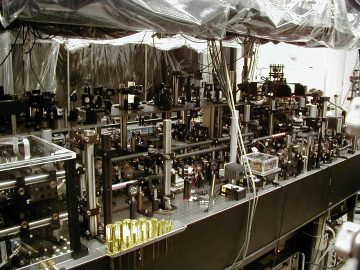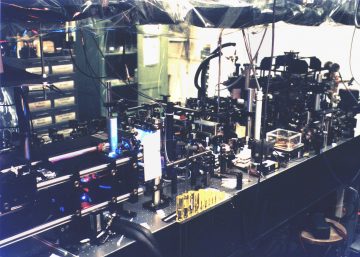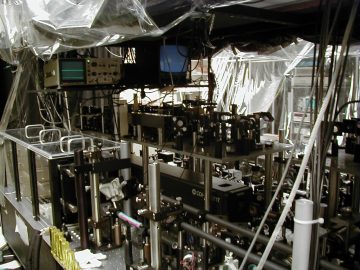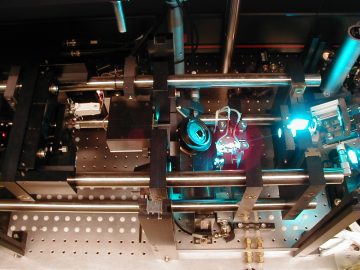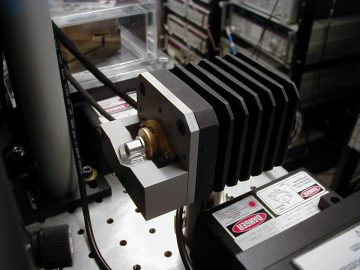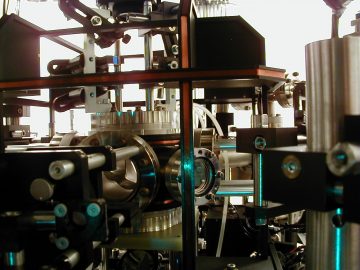This is a copy of the original photo tour written by Daniel Steck. Dan and I were both students of Mark Raizen at the University of Texas at Austin, and although this is a photo tour of Dan’s Cesium trapping experimental apparatus, my Sodium apparatus (see the last photo in this tour) and the ones we are buildling in this lab, are basically the same as pictured here.
This is just a brief tour of my Ph.D. experiment in Mark Raizen’s lab at The University of Texas at Austin. This will give you a rough idea of what the experiments I have planned look like, although there will be a lot of updates and improvements. This was an experiment that used ultracold cesium atoms to study fundamental effects in the areas of quantum chaos and the quantum–classical transition. In the same lab, just beyond the curtain, there is another similar experiment, but I don’t have any good pictures of it (save for the last one). This lab looks a lot different now; since I left, it has been converted to a rubidium BEC experiment.
You can click on any of the photos to get larger versions.
- The heart of the experiment is a bunch of optics on an optical table. And I do mean a bunch. Don’t worry too much, though; I started in the fall of 1995 with a blank table, and this photo was taken in the late summer of 2001. Even though it looks like a mess, it was quite managable for 2 or 3 people to build it up over 6 years. The experiments I’m planning may get to look like this over that time, but the initial experiments in 1-2 years will look simpler. Just to give you a sense of scale, the optical table here measures 4’x12′ (I’m planning on a 5’x12′ table to reduce some of the “skyscraper effect” that you see here). Like I said, these aren’t easy experiments, but once you get one of these working, you’ll be a damn good experimentalist.
- This is approximately the same photo taken some three years earlier, just to show you the progression of the experiment. The experiments were pretty simple back then.
- This is a view of the other end of the table. More optics, and you can see the two big lasers of the experiment, a Ti:sapphire laser and the argon-ion laser that pumps it. These probably won’t be necessary, since diode lasers can give similar performance now at much lower cost and effort. However, a large 1 micron solid-state laser will be necessary for some of the experiments.
- This is a closeup of the Ti:sapphire laser, where you can see the crystal being pumped by the argon-ion laser light. Again, not so relevant for experiments I’m planning, but hey, it’s a cool picture, no? Incidentally, this is a home-built laser. It was actually a home-built dye laser based on a design by Jim Bergquist at NIST when I started. Then Bruce Klappauf (another grad student) and I tore it apart and used the pieces to build this laser.
- This is a homebuilt, grating-stabilized diode laser. We used this for the repump light of the magneto-optical trap, if that means anything to you. They’re still using a modification of this laser with much success, and the Heinzen group at UT also adopted this design, so I’m planning to stick with this laser rather than commercially available designs.
- This is a distributed Bragg reflector diode laser, which stabilizes itself to the proper wavelength without any external optics. Pretty cool and simple, but not as good performance as the other laser. This was our primary laser for our atom trap. These aren’t really available anymore, so I don’t plan to use these, but I plan to slave some high-power diodes from the grating-stabilized lasers, and the slaves will look something like this. That’s a collimation lens in front of the laser diode there, and it’s supported by two glass rods and glued into place. Sounds strange, but this was based on an idea in use at the ENS in Paris, and once we switched to this design, the beam line would stay aligned for months at a time. Very nice.
- An up-close view of the vacuum chamber, where the atoms actually get trapped. It’s kind of big compared to what I’m thinking for the future, which will be based on smaller, all-glass cells, with independent sections for trapping and science. You couldn’t actually see the atoms with your eye even if the lasers were on in this photo, since the 852 nm resonance is too far in the infrared to be visible. (Well, you actually can see 852 nm light at sufficiently high intensities, but then it’s not exactly good for your eye.)
- And of course no experiment would be complete without…5 racks full of electronic equipment. There’s a good mix of homebuilt and commercial stuff here, all for controlling and debugging the experiment. Again, this isn’t nearly as unreasonable as it looks. I’d also like to build up a system of control equipment that is homebuilt and internet-compatible, with the goal of replacing commercial equipment that you see here that is based on surprisingly old technology given its price.
- Finally, a photo of the other experiment to show you what trapped atoms actually look like. In the center of that glass vacuum cell is a cloud of 100,000 trapped sodium atoms. Sodium is kind of a painful atom to work with though, so don’t expect to see any yellow atoms in my lab like this (much more likely are red clouds of rubidium atoms).
